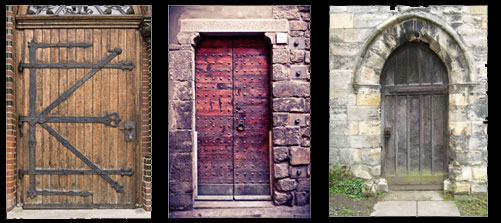Stygian Sentinel 14
Issue #14, November 9th 2015
What is a Physics-Based Game?[edit]
We hear this a lot. Physics have been an accepted part of games since the late 90's. Karma and Havok both made physics engines widely available for game developers. PhysX is built into every NVidia card. Not exactly revolutionary technology. Yet few games go deep in their use of physics and gameplay. Underworld Ascendant does...
Let's take the simple door as an example. In most games doors are just things you open or close. Opening the door is usually just playing a simple animation and turning its physics collider off so that you can walk through it.
A door in the Underworld is physically modeled out as a heavy wood or metal object attached to pivoting hinges, optionally with a locking mechanism. Doors have parameters for physical strength, resistance to fire damage, resistance to magic, their acoustic blocking factor, strength and complexity of any lock. What does this mean for when a player encounters a door?
- Player might smash through weaker doors. If door is susceptible to fire, they might burn it to weaken it, then smash through.
- Could pick the lock, or possibly smash the lock.
- Might spike the door closed to prevent a creature from opening it from the other side.
- Could listen at the door to try to hear what's moving around on the other side.
- Use a magic spell to unlock and open the door; or use magic to bind the door and block it closed.
This gives the player a bunch of options for just doors. This same physical approach extends to traps, chests, and rope bridges... pretty much anything you can interact with. Want to use that table to block a doorway. Go for it, if you can move it. Want to use that beam as a platform to span a subterranean stream? All those simple machines you remember studying in school - pulley, lever, screw, gears, and inclined planes - are tools at your disposal.
This simulation approach also ends up applying to other game systems. AI, communication, and even quest creation. Every system we look at we attempt to add common sense real world logic to it, at least within reason and with fun always in mind.
What is interesting about this type of simulation approach is as a player I just have a problem to solve or have a goal to achieve. I don't have to think about what the developer wants me to do. I don't have to worry about the 'right' thing to do. I might solve it simply, or go for a complex or challenging solution. Honestly both can be extremely rewarding.
This level of physical simulation is quite rare for RPG games, but some other genre games that use a similar approach you may want to check out:
Other News[edit]
We are excited to announce that we expect to have the First Playable Prototype build just before Thanksgiving, available to Backers in the $300 and higher Pledge tiers, who get special early access to this first build. A few weeks later we'll distribute this build more broadly. More details will be emailed out directly to Backers in the next week on how to download the build.
We will be having another Twitch session! This time with Austin Grossman and Raphael Colantonio we will be playing one of our favorites, Dishonored. Join us Tuesday Nov. 17th at 2pm Eastern.
Also, a heads-up that we'll be processing credit card payments for those Backers who have pledged through Backerkit next Monday the 16th. If you backed through Kickstarter or PayPal this will not affect you, as those payments have already been processed. We plan to continue to accept new pledges through Backerkit and PayPal at least through early next year, with the goal of achieving a couple more of the stretch goals.
The OtherSide Team



